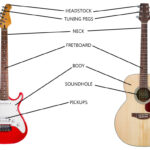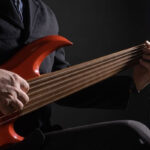Just back from an amazing trip to Japan, hitting Tokyo, Kyoto, and Nagoya! While my partner explored other interests (and tackled the epic task of packing a year’s worth of study abroad belongings!), I dedicated my time to a crucial mission: visiting Guitar Stores. Though photos weren’t allowed in many places, I dove deep into the guitar scene across these vibrant cities, and I’m excited to share my experience. For anyone passionate about guitars, Japan is a treasure trove.
My personal favorites were the big chain stores: Ishibashi, Ikebe, and Big Boss. However, it’s fascinating how much the inventory varies from location to location even within the same chain. If you’re on the hunt for a specific piece of gear or a great deal on used instruments, Digimart.net is an absolutely essential online resource to check.
One standout experience was the ESP Museum in Shibuya. Completely free to enter, it features two rooms filled with guitars displayed like precious artifacts. The exhibits are curated and change periodically. During my visit, they were showcasing the evolution of ESP’s Angel guitars, and it was incredible to witness how these instruments transformed into elaborate works of art over time. There was also a fantastic selection of V-style guitars and unique custom builds. If you’re any kind of guitar enthusiast, the ESP Museum is a must-visit location. Conveniently, there’s a well-stocked guitar store downstairs carrying ESP, Edwards, and LTD brands. While you can find many of these models in other stores at similar prices, it’s still worth a look in conjunction with the museum visit.
Then there’s the Fender Flagship Tokyo showroom in Shibuya. This place had a distinct “high-end boutique” atmosphere, almost like a fancy bag or watch store. It felt overly spacious and sterile compared to the wonderfully crammed and buzzing energy of typical guitar stores. Surprisingly, the selection of truly high-end, drool-worthy models was a bit thin on the ground. It seems the focus here is more on showcasing Fender’s latest production lines and Japan-exclusive models. To be honest, I left wondering about the core purpose of this particular store.
Interestingly, several stores in tourist-heavy areas seemed to smartly curate their first floors to feature primarily Japanese-made guitars. This is a brilliant move for international visitors like myself who are keen to explore local craftsmanship without immediately wading through the ubiquitous walls of US Gibson, Fender, and PRS models which we can find easily back home. ESP guitars were prominently displayed, alongside Fender Japan and Ibanez. I also discovered other noteworthy Japanese brands like Killer guitars (designed by Akira Takasaki of Loudness fame), Momose, Bacchus, and several others that escape my memory at the moment.
If you are in the market for those classic US brands, Japan is genuinely a fantastic place to buy. I consistently saw Gibson and Fender guitars in Japanese stores that were simply superior to what I typically encounter in Finland. High-end PRS models were also readily available, and seeing these top-tier instruments made it almost impossible to even glance at the SE or S2 ranges – the premium models were just so much more captivating! For those with deeper pockets, the vintage guitar stores also hold some truly incredible vintage pieces, albeit with prices that will certainly make your eyes water.
Some of the guitar stores were located in rather unexpected places. I stumbled upon one gem on the 10th floor of a building that was otherwise populated by dental clinics and… body hair waxing salons. The juxtaposition was quite amusing – the thought of someone getting their grooming done and then heading straight to shred on a Marshall stack in a guitar store is certainly unique to Japan!
Amp selection is plentiful. The most common amps available for testing were Marshall JVM stacks and Roland JC120s, but beyond those standards, you could find everything from Diezel to Two-Rock. The only Japanese amp brand I distinctly recall seeing was AKG Sound, known for their Dumble-style amplifiers, which were definitely in the higher price bracket.
In a Hard Off store (a chain specializing in used goods ranging from cameras to musical instruments), I even spotted a 1964 Bassman head and cabinet priced around 660,000 yen (approximately $4530 USD). It was surreal to find such a high-end vintage amp in a store known for more general used goods. These Hard Off stores also occasionally held surprises like high-end Custom Shop Fender guitars.
Pedal enthusiasts will be in paradise. Get Stomp in Ikebukuro remains my top recommendation for pedals simply due to their sheer selection. However, don’t expect to find bargain deals there. For those interested in modelers, pretty much every major brand was available to try, from Fractal and QC to TMP, Hotone, and Kemper. I briefly tested the Hotone Ampero II Stage (mainly to check out the user interface), and it seemed surprisingly capable for a more budget-friendly device.
For the sheer density and variety of guitar stores, Tokyo and Osaka are undoubtedly superior to Kyoto or Nagoya. The Ochanomizu area in Tokyo is legendary for its concentration of guitar stores. However, be aware that there can be a significant overlap in inventory between stores in Ochanomizu, so its strength lies in being able to meticulously compare multiple examples of a particular model to find the perfect one for you.
I resisted the urge to test out too much gear in the stores. Engaging with a store employee to get everything set up for a demo, only to walk out without buying anything, felt a bit awkward!
Price-wise, it was a mixed bag. Some guitars were priced only slightly less than what you’d find in Finland (minus VAT), and the same went for some pedals. Interestingly, Strymon pedals were notably cheaper, while brands like UA, Meris, and Source Audio were about the same price as elsewhere. Boss pedals, as always, represent good value. If I were seriously shopping, I’d probably focus primarily on Japanese-made guitars and used instruments to find the best value and unique pieces.
In the end, my only purchase on this trip was a Strymon El Capistan V2 pedal. Honestly, I already have a pretty great guitar collection at home, and seeing so many incredible instruments in Japan actually reinforced my appreciation for what I already own. But for any guitar player, exploring the guitar stores of Japan is an unforgettable experience.


